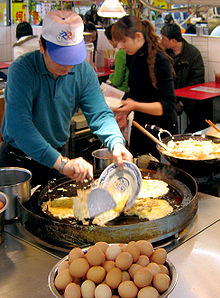- Xiaochi
-
Xiaochi (Chinese: 小吃; pinyin: xiǎochī; literally "small eats[1]") are an important category of Chinese food, substantial snacks along the lines of Spanish tapas or Levantine meze.
Xiaochi are not typically cooked in homes nor are they featured prominently on the menus of more formal reaturants (although a few courses of a multi-course banquet might be xiaochi). Instead, they are street food sold in markets at special stalls or small restaurants that specialize in a few or even just one xiaochi. Night markets are especially known for their specialty xiaochi food items. Here, xiaochi are either served as carry-out or sometimes at small tables with stools for seating. Taiwanese food critic Shu Kuo-chih describes xiaochi as "food from a street stall, shop or even a restaurant that comes in small portions and could never be considered a 'square meal' on its own. In New York, he says, 'hot dogs or nachos could be xiaochi.' Dim sum? Definitely."[2]
Xiaochi are highly local and, in some cases, one city's markets, or even one particular market or restaurant, can become famous for a particular type of food. The city will often become known for that food and the city name be used as an identifier or an attribution of quality (e.g. Chengdu xiaochi in Beijing). Specific types of xiaochi will often change from year to year with passing fads but staples persist.
Xiaochi form a large part of the traditional fourth meal of the day, the xiaoye (宵夜; "supper" or "midnight snack").
Even smaller pre-made side dishes are known as xiaocai (小菜).
Contents
Xiaochi in mainland China
There are a number of eclectic xiaochi such as Tujia pizza or Chinese pizza supposedly derived from the food of the Tujia minority people of Hubei. At Beijing's famous Jiumen Xiaochi (九门小吃) built in 2006, outlets include "Qian's glutinous rice cake, Wei's cheese juice, Li's flour tea, pouch-shaped baked wheaten cake, Yue Sheng Zhai's stewed marinated beef, Ma's water-boiled sheep head mutton, and Bai's jellied bean curd...Feng's boiled beef stomach, and Chen's boiled pork's small intestines and lungs with baked cake."[3]
Xiaochi in Taiwan
 Keelung Miaokou Night Market-style Taiwanese tempura
Keelung Miaokou Night Market-style Taiwanese tempura
Xiaochi are on the cutting edge of imbuing Taiwanese cuisine with foreign influences. Portuguese-style egg tarts, Middle-Eastern-derived shawarma, American steaks, Japanese udon noodles, and many mainland Chinese foods have all factored prominently in Taiwanese xiaochi. As Taiwan has become increasingly affluent, xiaochi have become an important part of the culinary culture.[1]
Taiwanese xiaochi can be divided into several categories including poultry, meat, fish and seafood, rice and noodle dishes, tofu and vegetarian dishes, pastries, sauces and pickles, and beverages.[1]
Although often associated with street food and night markets, Taiwan also has award-winning restaurants based on xiaochi such as the Din Tai Fung chain.
Notable Taiwanese xiaochi
- yōkan (iûⁿ-kiⁿ)
- stinky tofu (chhàu tāu-hū)
- shuangbaotai (bé-hoe-chìⁿ)
- pork ball soup (kòng-ôan-thng)
- popiah (po̍h-piáⁿ)
- oyster vermicelli (ô-á mī-sòaⁿ)
- oyster omelet (ô-á-chian)
- jiaozi (chúi-kiáu)
- grass jelly (sian-chháu)
- douhua (tāu-hū-hoe)
- baozi (bah-bau)
- bah-ôan
- aiyu jelly (ò-giô)
See also
References and further reading
- ^ a b c Lin Ming-teh. "Popular Food Culture in Taiwan." Taiwan Government Information Office website. Retrieved 15 December 2010.
- ^ David Frazier. "Man of the Streets."
- ^ "Snack resurrection." at ChinaDaily.com.cn. 13 July 2006. Retrieved 20 June 2008.
- Shuenn-Der Yu. "Hot and Noisy: Taiwan's Night Market Culture." The Minor Arts of Daily Life: Popular Culture in Taiwan. David K. Jordan, Andrew D. Morris, and Marc L. Moskowitz, eds. Honolulu: Univ. of Hawai'i Press, 2004.
External links
- Beijing Snacks at TimeOut Beijing
Categories:- Appetizers
- Snack foods
- Fast food
- Meals
Wikimedia Foundation. 2010.

